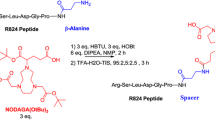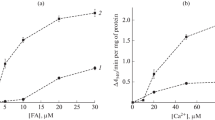Abstract
The aim of this study was to assess the phospholipid distribution of radioiodinated 17-iodoheptadecanoic acid (IHDA), 15-(p-iodophenyl)pentadecanoic acid (p-IPPA) and 15-(p-iodophenyl)-3,3-dimethylpentadecanoic acid (DMIPPA) under normoxic conditions and to compare these data with the fatty acid composition of the phospholipid classes. After simultaneous i.v. injection of the radioiodinated fatty acids (1-123-IHDA; 1-131-p-IPPA; 1-125 DMIPPA) in open-chest dogs seven myocardial biopsies were taken over 40 min (n = 26). After lipid extraction of the biopsies the organic phase was analyzed for both neutral and polar lipids by two different TLC systems. The following polar lipid fractions were analyzed: lysophopshatidylcholine (LPC), sphingomyelin (SPH), phosphatidy1choline (PC; lecithin), phosphatidylinositol (PI), phosphatidylserine (PS), phosphatidylethanolamine (PE), diphosphatidylglycerol (DPG; cardiolipin) and neutral lipids. Fractions were counted in a gamma well counter and corrected for cross-over and recovery. Results of the polar phospholipids analysis showed that IHDA has the highest incorporation into the phospholipids. The IHDA was mainly incorporated into PI (45.6%) followed by PC (30.9%), PE (14.0%) and PS (5.6%). The p-IPPA was predominantly incorporated incorporated into PC (37.2%), followed by PS (20.1%) and PE (13.7%). In contrast to IHDA, incorporation of p-IPPA into PI was small (6.4%). The DMIPPA analogue was incorporated into phopsholipids to only a very small degree, compared to IHDA and p-IPPA. PS (27.4%) was the only considerable phospholipid fraction into which DMIPPA was incorporated.
The results clearly demonstrated that these radioiodinated fatty acid analogues have entirely different patterns of phospholipid incorporation. Major resemblances have been found between the incorporation into phospholipids of IHDA and the phospholipid distribution of the natural counterpart: stearic acid. The p—IPPA phospholipid incorporation only partly resembles the phospholipid distribution of palmitic acid. DMIPPA is because of its modified structure, incorporated into phospholipids to a low extent, mainly into PS. (Mol Cell Biochem116: 79–87, 1992)
Similar content being viewed by others
References
Van der Vusse GJ, van Bilsen M, Reneman RS: Is phospholipid degradation a critical event in ischemia and reperfusion induced damage. News in physiological sciences (NIPS), 4: 949–953, 1989
Chien KR, Reeves JP, Buja LM, Bonte F, Parkey RW, Willerson IT: Phospholipid alterations in canine ischemic myocardium; Temporal and topographical correlations with Tc-99m-PPi accumulation and an in vitro sarcolemmal Ca2+ permeability defect. Circ Res 48: 711–719, 1981
Reimer KA, Jennings RB, Hill ML: Total ischemia in dog hearts. In vitro. II. High energy phosphate depletion and associated defects in energy metabolism, cell volume regulation, and sarcolemmal integrity. Circ Res 49: 901–911, 1981
Shaikh NA, Downar E: Time course of changes in porcine myocardial phospholipid levels during ischemia. A reassessment of the lysolipid hypothesis. Circ Res 49: 316–325, 1981
Corr PB, Gross RW, Sobel BE: Amphipathic metabolites and membrane dysfunction in ischemic myocardium. Circ Res 55: 135–154, 1984
Steenbergen C, Jennings RB: Relationship between lysophospholipid accumulation and plasma membrane injury during total in vitro ischemia in dog heart. J Mol Cell Cardiol 16: 605–621, 1984
Das DK, Engelman RM, Rousou JA, Breyer RH, Otani H, Lemeshow S: Role of membrane phospholipids in myocardial injury induced by ischemia and reperfusion. Am J Physiol 251 (Heart Circ Physiol 20): H71-H79, 1986
Miyazaki Y, Gross RW, Sobel BE, Saffitz JE: Selective turnover of sarcolemmal phospholipids with lethal cardiac myocyte injury. Am J Physiol 259 (Cell Physiol 28): C325-C331, 1990
Van der Vusse GJ, Roemen ThHM, Prinzen FW, Coumans WA, pReneman RS: Uptake and tissue content of fatty acids in dog myocardium under normoxic and ischemic conditions. Circ Res 50: 538–546, 1982
Chien KR, Han A, Sen A, Buja LM, Willerson JT: Accumulation of unesterified arachidonic acid in ischemic canine myocardium. Relationship to a phosphatidylcholine deacylation-reacylation cycle and the depletion of membrane phospholipids. Circ Res 54: 313–322, 1984
Prinzen FW, van der Vusse GJ, Arts T, Roemen THM, Coumans WA, Reneman RS: Accumulation of nonesterified fatty acids in ischemic canine myocardium. Am J Physiol 247 (Heart Circ Physiol 16): H264-H272, 1984
Man RYK, Slater TL, Pelletier MP, Choy PC: Alterations of phospholipids in ischemic canine myocardium during acute arrhythmia. Lipids 18: 677–681, 1983
Opie LH: Metabolism of the heart in health and disease. Am Heart J 76: 685–698, 1968
Van der Wall EE, Den Hollander W, Heidendal GAK, Westera G, Majid PA, Roos JP: Dynamic myocardial scintigraphy with 123-I-labeled free fatty acids in patients with myocardial infarction. Eur J Noel Med 6: 383–389, 1981
Visser FC, Eenige van MJ, Westera G, Den Hollander W, Duwel CMB, Van der Wall EE, Heidendal GAK, Roos JP: Metabolic fate of radioiodinated haptadecanoic acid in the normal canine heart. Circulation 72: 565–571, 1985
Visser FC, Eenige van MJ, Duwel CMB, Roos JP: Radioiodinated free fatty acids; can we measure myocardial metabolism? Eur J Nucl Med 12: S20-S23, 1986
Lerch RA: Effect of impaired fatty acid oxidation on myocardial kinetics of11C- and123I-labelled fatty acids. Eur J Nucl Med 12: S36-S38, 1986
Eenige van MJ, Visser FC, Duwel CMB, Karreman AJP, pLingen van A, Roos JP: Comparison of 17-iodine-131 heptadecanoic acid kinetics from externally measured time-activity curves and from serial myocardial biopsies in an open-chest canine model. J Nucl Med 29: 1934–1942, 1988
Eenige van MJ, Visser FC, Duwel CMB, Roos JP: Clinical value of studies with radioiodinated heptadecanoic acid in patients with coronary artery disease. Eur Heart J 11: 258–268, 1990
Duwel CMB, Visser FC, Eenige van MJ, Den Hollander W, Roos JP: The fate of1311-17-iodoheptadecanoic acid during lactate loading: its oxidation is strongly inhibited in favor of its esterification. Nucl Med 29: 24–27, 1990
Visser FC, Sloof GW, Eenige van MJ, Knapp FF: Radioiodinated heptadecanoic acid, phenylpentadecanoic acid and dimethylphenylpentadecanoic acid in the normal canine heart. Compari son of uptake, oxidation and lipid distribution. “(Abstr)” Eur Heart J 11: P524, 1990
Machulla HJ, Marsmann M, Dutschka K: Biochemical concept and synthesis of a radioiodinated phenylfatty acid for in vivo metabolic studies of the myocardium. Eur J Nucl Med 5: 171–173, 1980
Dudczak R: Myokardszintigraphie mit Jod-123 markierten Fetts5uren. Wien Klin Wochenschr 95: 1–38, 1983
Knapp FF Jr, Goodman MM, Callahan AP, Kirsch G: Radioiodinated 15-(p-iodophenyl)-3,3-dimethylpentadecanoic acid: a useful new agent to evaluate myocardial fatty acid uptake. J Nucl Med 27: 521–531, 1986
Knapp FF Jr, Ambrose KR, Goodman MM: New radioiodinated methyl-branched fatty acids for cardiac studies. Eur J Noel Med 12: S39-S44, 1986
Reske SN, Sauer W, Machulla HJ, Winkler C: 15(p-[123I]lodophenyl)pentadecanoic acid as tracer of lipid metabolism: comparison with [1-14Clpalmitic acid in murine tissues. J Nucl Med 25: 1335–1342, 1984
Reske SN, Schön S, Schmitt W, Machulla HJ, Knopp R, Winkler C: Effect of myocardial perfusion and metabolic interventions on cardiac kinetics of phenylpentadecanoic acid (IPPA) 1123. Eur J Nucl Med 12: S27-S31, 1986
Goodman MM, Kirsch G, Knapp FF Jr: Synthesis and evaluation of radioiodinated terminal p-iodophenyl-substituted α- and ßmethyl-branched fatty acids. J Med Chem 27: 390–397, 1984
Bligh EG, Dyer WJ: A rapid method of total lipid extraction and purification. Can J Biochem Physiol 37: 911–917, 1959
Rouser G, Fleischer S, Yamamoto A: Two-dimensional thinlayer chromatographic separation of polar lipids and determination of phospholipids by phosphorus analysis of spots. Lipids 5: 494–496, 1970
Roemen ThHM, van der Vusse GJ: Application of silica gel column chromatography in the assesssment of non-esterified fatty acids and phosphoglycerides in myocardial tissue. J of Chromatography 344: 304–308, 1985
Kropp J, Ambrose KR, Knapp FF Jr, Nissen HP, Biersack HJ: Incorporation of radioiodinated IPPA and BMIPPA fatty acid analogues into complex lipids from isolated rat hearts. J Nuc Med Biol. In press
Eenige van MJ, Visser FC, Duwel CMB, Bezemer PD, Westera G, Karreman AJP, Roos JP: Analysis of myocardial time activity curves of I-123 heptadecanoic acid; I curve fitting. Nucl Med 26: 241–247, 1987
Author information
Authors and Affiliations
Rights and permissions
About this article
Cite this article
Sloof, G.W., Visser, F.C., Teerlink, T. et al. Incorporation of radioiodinated fatty acids into cardiac phospholipids of normoxic canine myocardium. Mol Cell Biochem 116, 79–87 (1992). https://doi.org/10.1007/BF01270573
Issue Date:
DOI: https://doi.org/10.1007/BF01270573




